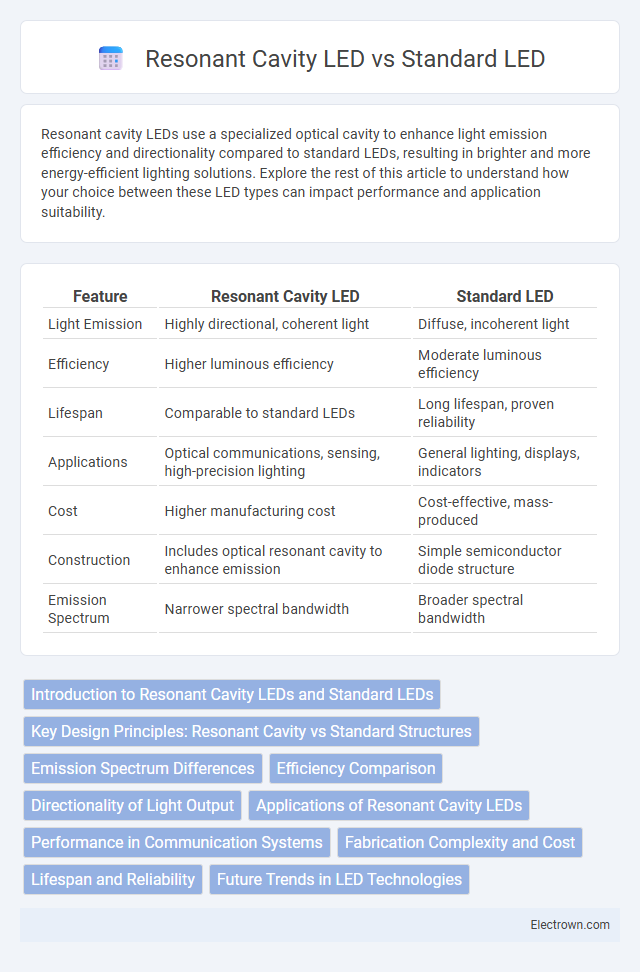Resonant cavity LEDs use a specialized optical cavity to enhance light emission efficiency and directionality compared to standard LEDs, resulting in brighter and more energy-efficient lighting solutions. Explore the rest of this article to understand how your choice between these LED types can impact performance and application suitability.
Table of Comparison
| Feature | Resonant Cavity LED | Standard LED |
|---|---|---|
| Light Emission | Highly directional, coherent light | Diffuse, incoherent light |
| Efficiency | Higher luminous efficiency | Moderate luminous efficiency |
| Lifespan | Comparable to standard LEDs | Long lifespan, proven reliability |
| Applications | Optical communications, sensing, high-precision lighting | General lighting, displays, indicators |
| Cost | Higher manufacturing cost | Cost-effective, mass-produced |
| Construction | Includes optical resonant cavity to enhance emission | Simple semiconductor diode structure |
| Emission Spectrum | Narrower spectral bandwidth | Broader spectral bandwidth |
Introduction to Resonant Cavity LEDs and Standard LEDs
Resonant cavity LEDs (RCLEDs) utilize a microcavity structure that enhances light emission efficiency and spectral purity by confining photons within a resonant optical cavity. Standard LEDs emit light through spontaneous emission without optical feedback, resulting in broader spectral width and lower directional emission. The RCLED's design enables higher modulation speeds and improved coupling efficiency, making them ideal for high-performance optical communication and sensing applications compared to conventional LEDs.
Key Design Principles: Resonant Cavity vs Standard Structures
Resonant cavity LEDs utilize a microcavity structure that enhances light extraction by confining photons within a precisely engineered optical cavity, leading to narrow spectral linewidths and improved directionality. Standard LEDs rely on broad emission layers without such optical confinement, resulting in wider emission spectra and less directional output. Your choice between these technologies impacts efficiency, spectral purity, and overall device performance tailored to specific applications.
Emission Spectrum Differences
Resonant cavity LEDs exhibit a narrower emission spectrum compared to standard LEDs, resulting in enhanced color purity and spectral stability. The resonant cavity structure confines specific wavelengths, producing a highly monochromatic output optimized for applications in optical communications and precision sensing. Standard LEDs typically emit a broader spectrum with lower spectral coherence, making resonant cavity LEDs advantageous where precise wavelength control is critical.
Efficiency Comparison
Resonant cavity LEDs (RCLEDs) exhibit higher efficiency than standard LEDs by enhancing light extraction through a microcavity structure that confines and directs photons more effectively. This design optimizes the spontaneous emission rate and spectral purity, leading to increased luminous efficacy and reduced energy loss. Your choice of RCLED technology can result in better energy savings and improved device performance compared to conventional LEDs.
Directionality of Light Output
Resonant cavity LEDs (RCLEDs) feature enhanced directionality of light output due to their optical cavity design, which confines and directs photons more efficiently compared to standard LEDs. This results in a narrower emission angle and higher brightness within a focused beam, making RCLEDs ideal for applications requiring precise light targeting. Standard LEDs emit light more diffusely with a wider angular spread, leading to lower intensity in any specific direction.
Applications of Resonant Cavity LEDs
Resonant cavity LEDs (RCLEDs) are ideal for high-speed data communication, optical sensing, and precision measurement applications due to their narrow spectral linewidth and high modulation bandwidth. Their enhanced emission directionality and wavelength stability improve performance in fiber optic communications and biometric sensors. You can leverage RCLED technology in environments that require efficient, high-speed optical sources with precise wavelength control.
Performance in Communication Systems
Resonant cavity LEDs (RCLEDs) offer higher modulation bandwidth and improved spectral purity compared to standard LEDs, making them more effective for high-speed optical communication systems. Their enhanced directionality and narrow spectral linewidth reduce dispersion and signal loss, resulting in better data transmission quality and longer reach. Standard LEDs typically have broader emission spectra and lower modulation speeds, limiting their performance in advanced communication applications.
Fabrication Complexity and Cost
Resonant cavity LEDs (RCLEDs) involve more complex fabrication processes due to the integration of optical microcavities and precise layer thickness control, resulting in higher production costs compared to standard LEDs. Standard LEDs use simpler epitaxial growth and packaging methods, making them more cost-effective for mass production. The intricate design and sophisticated materials required for RCLEDs limit their scalability and increase their price relative to conventional LEDs.
Lifespan and Reliability
Resonant cavity LEDs offer enhanced lifespan and reliability compared to standard LEDs due to their advanced cavity design that improves light extraction efficiency and reduces thermal stress. This results in less degradation over time, making resonant cavity LEDs ideal for applications demanding long-term performance and consistent brightness. Your choice of resonant cavity LEDs ensures extended durability and stable operation in demanding environments.
Future Trends in LED Technologies
Resonant cavity LEDs (RCLEDs) offer enhanced light extraction efficiency and narrower spectral linewidths compared to standard LEDs, making them ideal for high-speed optical communication and sensing applications. Future trends in LED technology emphasize integrating RCLEDs with photonic circuits and advanced materials like perovskites to achieve higher brightness, improved thermal management, and tunable emission wavelengths. This evolution supports the growing demand for energy-efficient, high-performance lighting and communication devices in IoT, autonomous vehicles, and augmented reality systems.
Resonant cavity LED vs Standard LED Infographic

 electrown.com
electrown.com